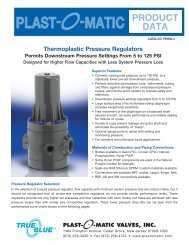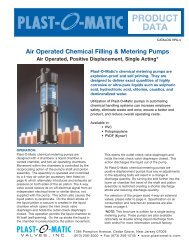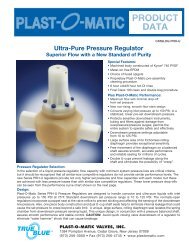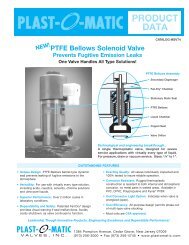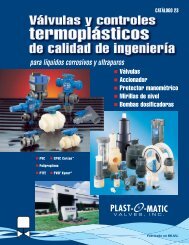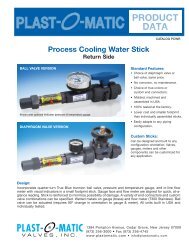Installation Instructions [PDF format] - Plast-O-Matic Valves, Inc
Installation Instructions [PDF format] - Plast-O-Matic Valves, Inc
Installation Instructions [PDF format] - Plast-O-Matic Valves, Inc
You also want an ePaper? Increase the reach of your titles
YUMPU automatically turns print PDFs into web optimized ePapers that Google loves.
ASSEMBLY, INSTALLATION & OPERATING INSTRUCTIONS<br />
FOR TRUE-BLUE ELECTRIC ACTUATOR<br />
MODELS EBV-65 & EBV-104<br />
A. Mounting of Electric Actuator to Ball Valve<br />
1. Close the ball valve and hand tighten the union nuts.<br />
Remove the handle<br />
2. Actuators will normally be supplied in the closed<br />
position. Check to be sure the ball valve shaft is properly<br />
aligned with the recess on the bottom of the actuator. If<br />
they are not aligned, rotate the actuator override wheel to<br />
the left until the recess is aligned with the shaft.<br />
3. Position the actuator over the ball valve so that the ball<br />
valve shaft slides into the recess.<br />
4a. Mounting of 1 /2", 3 /4" and 1" <strong>Valves</strong>: Select the proper<br />
mounting hardware bag to mount the valve size being<br />
used ( 1 /2", 3 /4", 1"). See parts drawing on reverse. Slide<br />
the two (2) upper spacers between the bottom of the<br />
actuator and the mounting lugs of the ball valve. When<br />
mounting 1 /2" and 1" ball valves, only two (2) spacers are<br />
used. When mounting 3 /4" ball valves, a total of four (4)<br />
spacers are used; the shorter (2) spacers are used in the<br />
upper position while the longer (2) spacers are used in<br />
the lower position. When using 1 /2" and 1" ball valves,<br />
there will be two (2) leftover spacers - discard them.<br />
4b. Mounting of 1 1 /4", 1 1 /2" and 2" <strong>Valves</strong>: Slide the two (2)<br />
spacers between the bottom of the actuator and the<br />
mounting lugs of the ball valve. See parts drawing.<br />
5. To avoid loosening due to vibration or continued cycling,<br />
use a couple of drops of Loctite #2128 thread adhesive<br />
on the bolt threads. Insert the mounting bolts through the<br />
lugs and spacers, then thread the mounting bolts snugly<br />
into the mount of the actuator. Tighten 1 /4 turn past hand<br />
tight. Use extreme caution to prevent stripping out plastic<br />
threads.<br />
B. <strong>Installation</strong> of Actuator & Ball Valve Assembly<br />
into Piping System<br />
1. Mounting Position: Always mount the actuator in the<br />
“upright” position.<br />
2. Flow Direction: Due to the Trunnion design these valves<br />
are capable of handling flow and pressure in either<br />
direction.<br />
3. Threaded Connections: Use PTFE tape or a suitable<br />
pipe sealant on the threaded connections. Use a strap<br />
wrench to tighten only 1 /4 turn more than hand tight. Do<br />
not use metal pipe wrenches.<br />
4. Socket Connections: (PVC and CPVC only). Pipe ends<br />
must be cut off square and deburred. Clean pipe and<br />
valve end connector socket with proper cleaning solvent.<br />
After cleaning apply solvent cement with a brush to both<br />
the pipe and socket. Immediately insert pipe into socket<br />
rotating the socket about 1 /4 turn during insertion.<br />
CAUTION: It is best to do this with socket end connector<br />
disassembled from valve to avoid getting solvent cement<br />
inside the valve. If you are not familiar with solvent<br />
cementing, contact your <strong>Plast</strong>-O-<strong>Matic</strong> distributor for<br />
further in<strong>format</strong>ion.<br />
5. To maximize cycle-life of ball valve, turn the union nuts<br />
onto the ball valve hand tight only. Approximately 1,000<br />
cycles later tighten again by hand or with a strap wrench<br />
and the valve will never again need adjusting or<br />
tightening.<br />
6. Supporting the Ball Valve and Actuator Assembly:<br />
Tapped holes ( 1 /4 - 20 for EBV-65, 3 /8 -16 for EBV-104)<br />
have been provided on the bottom of the two mounting<br />
nuts. These tapped holes insure quick, easy mounting to<br />
a bracket or support.<br />
7. Disassembly of Downstream Piping: The Trunnion design<br />
of this valve enables you to disassemble the downstream<br />
piping from the valve by unscrewing the valve’s<br />
downstream union without leakage from the upstream<br />
pressure. The valve must be in the closed position before<br />
doing this. Use extreme caution with dangerous fluids.<br />
8. Valve Removal From Piping: The True Union design<br />
enables you to simply unscrew the two valve union nuts and<br />
slide the valve body away from the piping. Pressure or liquid<br />
head must be removed from both sides of valve before<br />
doing this. Use extreme caution with dangerous fluids.<br />
C. Connecting Actuator to Electrical System<br />
Follow all local wiring codes when wiring this actuator. Check<br />
the power requirement label (located on the cover directly<br />
above the conduit fitting) to be sure it matches the power<br />
source. The switch shown in the customer wiring section<br />
must remain in each position (open or closed) for a minimum<br />
of 8 sec. The switch may be left in either position for an<br />
infinite amount of time. If the control of this switch is<br />
independent of time (example - liquid level switch), the<br />
minimum amount of time that the switch could remain in each<br />
position should be determined.<br />
Note: Momentary signals or signals lasting less than 8 sec.<br />
may be used, however extra circuitry is needed, Consult your<br />
nearest distributor or the factory for details.<br />
1. Remove the screws which fasten the cover to the base<br />
(make sure the actuator is in the upright position).<br />
2. Remove the cover and refer to the wiring diagram inside.<br />
3. Install a suitable watertight conduit fitting into the 1 /2"<br />
NPT threaded conduit boss.<br />
4. Feed all wiring through the threaded conduit boss, then<br />
attach them to the top half of the terminal block as per<br />
the diagram. Do not remove the motor and switch plate<br />
assembly from the base.<br />
D. Testing The Actuator<br />
1. Apply power to the actuator using extreme caution to<br />
avoid contact with open electrical connections.<br />
2. Position the switch (in the customer wiring section) so<br />
that the amber light turns on. The rotor should spin.<br />
3. Due to the possibility of abnormally rough handling<br />
during shipment, the sleeve bearings in the motor may<br />
become misaligned, and cause sticking. This problem<br />
can easily be handled during installation as follows;<br />
grasp the rotor, lift slightly then spin by hand counterclockwise<br />
several times until the rotor spins freely.<br />
4. Cycle the actuator from position<br />
to position (open, closed) to<br />
check for proper wiring<br />
and operation.<br />
5. Replace the cover and<br />
mounting screws. Do not<br />
over-tighten the cover<br />
mounting screws.<br />
PLAST-O-MATIC VALVES, INC.<br />
1384 Pompton Avenue, Cedar Grove, NJ 07009 USA<br />
(973) 256-3000 • Fax: (973) 256-4745 • www.plastomatic.com • info@plastomatic.com<br />
SERIES “EBV-65” & “EBV104” INSTALLATION DATA SHEET<br />
SEE REVERSE SIDE<br />
FOR PARTS LISTS
SERIES “EBV-65” & “EBV-104” ELECTRIC ACTUATOR PARTS LIST<br />
E. Manual Override Operation<br />
In the event of a power failure, the valve position may be<br />
changed by rotating the override wheel. Rotate the wheel to<br />
the left [← ] (with the actuator vertical) using a lever – such<br />
as a screwdriver – until the desired position is reached.<br />
CAUTION: Do not attempt to override the actuator while<br />
power is still supplied since rotation of the override wheel will<br />
cause the motor to turn on. This could cause jamming of the<br />
lever being used and possible damage to the actuator.<br />
Always remove the lever from the override wheel.<br />
Positioning of Override During Power Failure: The actuator<br />
can be manually positioned to operate in two ways when the<br />
power is re-applied:<br />
1. Respond to the signal (open, closed) being sent to the<br />
actuator. Override Procedure:<br />
Rotate the override wheel until the<br />
arrow points to the extreme left of<br />
the solid line.<br />
2. Remain at the position (open, closed) chosen at the<br />
time of override. The actuator will re-synchronize with<br />
the actuation signal after one position change.<br />
Override Procedure: Rotate the<br />
override wheel until the arrow points<br />
to the extreme right of the solid line.<br />
These functions are provided for your<br />
convenience only. This is not a safety feature. Be sure to<br />
plan a safe start-up procedure in case of a power failure.<br />
NOTE: <strong>Plast</strong>-O-<strong>Matic</strong> should be contacted immediately if there<br />
are any questions regarding the product or installation.<br />
EBV-65 AND EBV-104 PARTS LIST<br />
ITEM QTY DESCRIPTION<br />
1 1 Cover Assembly<br />
2 1 Motor<br />
3 1 Switch Plate<br />
4 1 Harness & Light Assembly<br />
4A 2 Heat Shrink Tubing<br />
4D 4 Round Head Screw; #4-40 x 5 /8" Long<br />
4E 2 Wire Splice<br />
4F 1 Harness<br />
4G 1 Amber Light<br />
4H 2 Roller Switch<br />
4J 1 Red Light<br />
4K 3 “O” Ring for Lights<br />
4L 1 Green Light<br />
4M 1 Terminal Switch<br />
5 4 Flat Head Screw #10-32 x 1 /4" Long<br />
6 1 Base<br />
7 2 Filister Head Screw #4-40 x 3 /8" Long<br />
8 1 “O” Ring for Override Wheel<br />
9 1 Upper Thrust Washer<br />
10 2 Dowel Pin<br />
11 2 Spring<br />
12 1 Hex Insert<br />
13 1 Override Wheel<br />
14 1 Lower Thrust Washer<br />
15 1 Mount<br />
16 2/4 Spacers<br />
17 2 Mounting Stud<br />
18 6/8 Flat Head Screw<br />
19 6/8 “O” Ring for Cover<br />
20 2 Flat Head Screw #6-32 x 1 1 /4" Long<br />
21 4 Flat Head Screw #10-ST<br />
EBV WIRING DIAGRAM<br />
1384 Pompton Avenue, Cedar Grove, New Jersey 07009<br />
(973) 256-3000 • Fax (973) 256-4745 • www.plastomatic.com<br />
09/05


![Installation Instructions [PDF format] - Plast-O-Matic Valves, Inc](https://img.yumpu.com/35160235/1/500x640/installation-instructions-pdf-format-plast-o-matic-valves-inc.jpg)
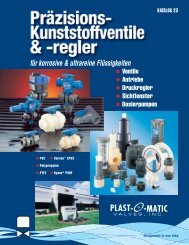
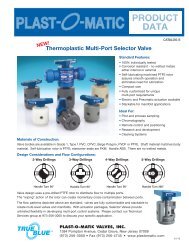
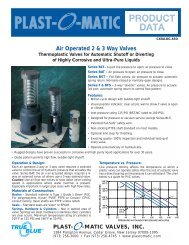
![Series TRVDT PTFE diaphragm 3-way relief valves [PDF format]](https://img.yumpu.com/45002261/1/190x245/series-trvdt-ptfe-diaphragm-3-way-relief-valves-pdf-format.jpg?quality=85)
